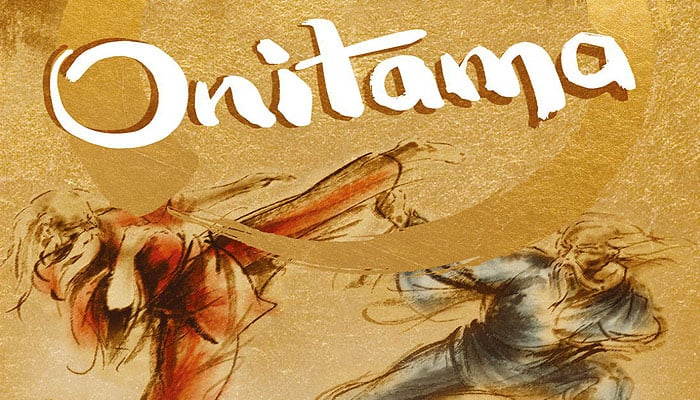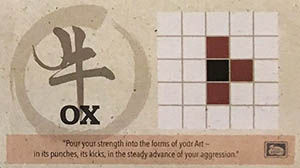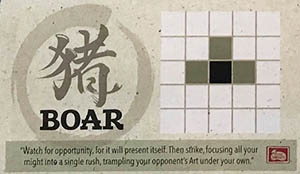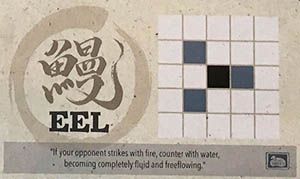
Onitama is an elegant and simple game which captures the essence of martial arts. Each game is quick, usually 15 minutes in length.
Components

2 master pawns
8 student pawns
16 move cards
Rollup Game Mat
Rulebook
Setup

Arrange the playmat on the table between you and your opponent.
Each player chooses 5 pawns of one color (1 master + 4 students). Each player places their Master pawn on the temple arch nearest them, and their 4 Student pawns on the 2 squares on either side of the master.
Shuffle the 16 Move cards. Give two- random cards to each player, face up - this is the player's "hand". Each player places both of their starting cards in front of them, face up.Turn over one more Move card, and examine the stamp in the lower right hand corner of the card.

The player with the pawns that are the same color as that stamp will go first.
Place this card so that it is on the right side of the game mat (with respect to the player going first). The rest of the Move cards will not be used -. return them to the box. You can use them in future games, to create new challenges and tactics.
Game Play
It is time to prove the power of your Art.
Combat at Onitama is simple and elegant, as befits a contest between two Masters. You and your opponent will take turns following the two steps below, one for the body, one for the spirit.
On your turn, follow each of these two steps, ir this order:
Step 1: Move & Attack
On your turn, examine and choose one of the two Move cards in front of you. Then, move one of your pawns'(student or master) as shown on that card. (The square grid will show you the way).

The black square in the middle represents the space your chosen pawn occupies. The colored spaces show where your pawn can move relative to its starting position. You can move your pawn to any one of the spaces indicated.
Other pawns (yours or your opponents) and Temple Arches do not block the movement of your pawn across the board.

You can never make a move that would cause a pawn to move off the board or move onto the same square as one of your own pawns.
If your pawn moves onto a square that is occupied by one of your opponent's pawns, the opponent's pawn is "captured" and removed from the game. Put it back in the box.
You must actually land on the piece to capture it - moving over or through a square occupied by an opponent's piece does not capture it.

Step 2: Exchange Cards
Take the Move card you just used, and place it to the left side of the playmat, rotating it 180 degrees to face your opponent.
Then take the card that is on the right side of your playmat and add it to your hand. You may use that card starting next turn, as one of the two Move cards you can choose from.

Now it is time for your opponent to take a turn, following the same two steps.
You shall continue to take turns until one of you has won the game, demonstrating mastery of your Martial Art.
What If I Don't Want To Move
If you have a legal move, you must take it - even if you don't want to!
Be careful that your opponent does not trap you in a position from which you cannot escape.
It is possible that you will find that you cannot use any of your cards to make a legal move. If this happens - and only then - you must pass your turn.
None of your pawns will move. But like the river that constantly flows, you cannot remain unchanged: you must still choose one of the two cards in front of you, place it to the left of the playmat and rotate it, then take the card from the right side of the board.
Cards
















End of the Game
There are two ways to prove that your Art is stronger: the Way of the Stone or the Way of the Stream.
-
To win in the Way of the Stone, you must capture your opponent's Master pawn.

-
To win in the Way of the Stream, you must move your own Master pawn into your opponents Temple Arch space.

Neither path to victory is easy! You will need careful strategy to achieve your goals.
Continue Reading


